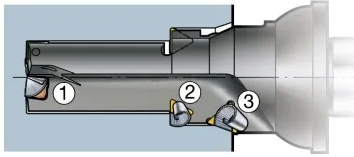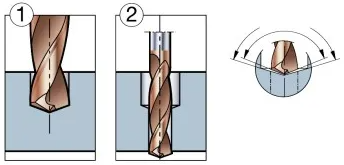STAGE DRILLING AND DRILLING OF TRACKS

- 1. Stage drilling
- 2. Step drill and drill clips
Drilling clips


What is a filmed hole?
A large number of all the holes produced need a clip or at least some scraping removal. Some typical examples are holes for screws and rivets.
You can choose from several drills, and with circular interpolation you can even use a turning or milling tool.
Hard carbide drills
Standard program of drills for 45 ° clips, adapted for different thread / tap holes up to a depth of 2-3 x DC holes.

How to use drilling clips
Normally, the same feed, fn (mm / rev), should be used when cutting the recording insert. This is important, especially when drilling a blind hole, because reducing the feed can cause long chips when drilling.
Sometimes, however, in materials with long chips, it may be necessary to adjust the feed during the mimicking process to prevent long chips from wrapping around the drill bit.
fn drillfn imitation

Step drilling and drilling of clips


Another common type of hole is a stepped or stepped and chamfered hole. Typical applications are components with countersunk screws or bolts.
Drilling stepped or stepped and chamfered holes
Holes for stairs / clips in one passage
Solid carbide drill bits - available with steps and clips.
Step holes by drilling two holes
Hard carbide drills - choose a drill according to the size and depth of the hole.
Step holes with drilling
Solid carbide drill bits - select the drill and drilling tool according to the size and depth of the hole.
Stepped holes with spiral interpolation
The diameter of the step hole can be 2 x DC. Screw interpolation is a slow operation and should not be used for deep steps. Choose a cutter according to the size of the hole.
Non-drilling drill
Select a standard drill and program the tool path.
How to start?
Holes for stairs / clips in one passage

The challenge when using multi-diameter tools is to achieve good chip breaking from all edges of the cut. For long-cut materials such as low-carbon steels and stainless steels, the initial tests must be carried out in the following steps:
- 1. First check the formation of chips from the drill bit
- 2. Check for chip formation on the step insert
- 3. Check the formation of shavings from the recording cartridge
Step holes by drilling two holes

First larger diameter, then smaller.
Always start drilling a large diameter to ensure centering of the drilling point and to prevent cutting of the cutting edges.
When drilling a small diameter, make sure that the angle of the drill points is equal to or smaller than the large drill bit to ensure that the tip first strikes the workpiece.
Are you interested in turning services?
See our offer:
For all questions we are at your disposal:
